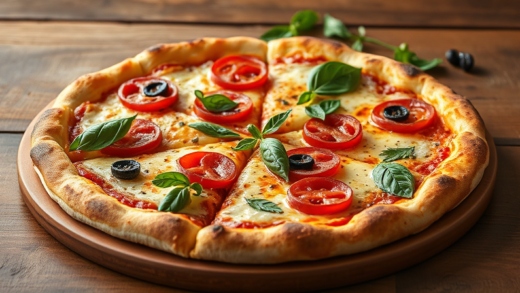Cozy Up With These Hearty Recipes
When cold winds whistle and mornings feel slower, nothing beats the comfort of a warm, hearty meal. These recipes aren’t just about food — they’re about sharing, lingering at the table, and filling your home with rich aromas and laughter. In this post, you’ll find step-by-step guidance for Italian-inspired feasts and British classics straight from Gordon Ramsay. Imagine beef cheeks so tender they fall apart, creamy panna cotta, spicy fig jam crostini, and a beef stew that chases away the winter blues.
This post breaks down Ramsay’s cook-along episode, giving you every essential trick, shortcut, and tip—without making things complicated. Ready to make your kitchen smell incredible?
Slow Cooked Beef Cheeks: The Ultimate Comfort Dish
If you’ve never cooked beef cheeks, now’s the time. Don’t be fooled by their humble reputation—beef cheeks, when slow-cooked, turn meltingly soft and full of flavor. They’re easy on the wallet and easy to love, once you know the process.
Preparing and Cooking the Beef Cheeks
- Season the beef cheeks generously with salt and pepper. Don’t be shy—seasoning brings the flavor.
- Pour a little oil into a hot pan. Sear the cheeks until you get a deep, golden color on every side. This color means flavor.
- Set the cheeks aside. In the same pan, add chunky onions and whole garlic cloves. Cook until they take on color and soften.
- Toss in a couple of bay leaves for an aromatic touch.
- Put the seared cheeks back in. Pour over a generous glass of red wine, scraping the bottom of the pan. This lifts all those caramelized flavors into your sauce.
- Skip the tomato puree and use chopped canned tomatoes. They’ll make the sauce richer.
- Add enough stock so the cheeks are mostly submerged—think little crocodile heads peeking up from the liquid.
With the lid set askew, braise in the oven at 140-150°C (285-300°F) for 3.5–4 hours. Resist the urge to fully cover the pot—leaving a gap helps steam escape so your sauce isn’t watery.
In the Restaurant
Cheeks take time, so top restaurants cook them first thing—early in the morning—leaving all that time for them to soften and soak up flavor.
When ready, the cheeks come out pillow-soft, sitting in a sauce deep enough to need extra bread for sopping up every last drop.
Pappardelle With Beef Cheek Ragu
Nothing completes slow-cooked cheeks like silky pappardelle. Cook the pasta the right way:
- Salt your boiling water well.
- Add a touch of good olive oil, then the pasta. Twirl it to avoid breaking the ribbons.
- Cook until just tender—about four minutes for fresh pasta.
Roughly chop flat-leaf parsley, and when the beef cheeks are ready, ladle some of that glossy braising liquid onto your serving platter. Layer the pasta on top, add the cheeks, and spoon more sauce over everything. Top with fresh parsley and another drizzle of olive oil.
Serve it up and watch people’s faces light up at the aroma and sight.
Starter: Fig Jam Crostini With Creamy Burrata
This starter brings a sweet, tangy, and creamy bite that’s everything you want at the top of a cozy meal.
Making the Fig Jam
- Slice fresh figs into small pieces. Sprinkle with sugar and a pinch of salt.
- Drop star anise (count how many you add so you can fish them back out—they bring flavor, not crunch).
- Let the sugar caramelize gently, then add the figs. Their juices will melt the sugar into a thick, sticky jam with a sweet, tart note.
- Add a dash of vanilla for warmth. Cook for about 3–4 minutes.
Assembling the Crostini
- Slice ciabatta or any rustic bread. Drizzle with olive oil on both sides.
- Grill or toast until golden.
- Spread each slice with warm fig jam, making sure to remove the star anise pods.
- Top with creamy burrata, give a light drizzle of oil, and sprinkle with lemon zest.
Every bite pops with the taste of summer, balanced by the richness of the burrata.
Dessert: Espresso Panna Cotta With Cinnamon Hazelnut Brittle
A meal isn’t truly finished without a sweet treat. Ramsay’s version brings Italy to your table in creamy, coffee-flavored spoonfuls.
Panna Cotta
- Soften two sheets of gelatin in cold water.
- In a small saucepan, mix cream, milk, sugar, and a shot of espresso.
- Heat gently to a simmer, then remove from the stove.
- Squeeze out the gelatin and stir into the hot cream until dissolved.
- Fill molds (rinse them with cold water first—it helps panna cotta slide out later).
- Chill for 2–3 hours, or overnight.
Cinnamon Hazelnut Brittle
- Put caster sugar into a pan and let it melt to a golden caramel.
- Toss in toasted hazelnuts, sprinkle with cinnamon, and let set.
- Once cool, break into shards for a crunchy, spicy topping.
To serve, unmold the panna cotta by dipping each mold quickly in hot water, then flip onto plates and top with a piece of brittle. Your guests will think you went to culinary school.
British Classic: Hearty Beef Stew With Mustard Dumplings
Switching gears from Italian comfort to a British hug-in-a-bowl, Ramsay’s beef stew is rich, robust, and packed with chunky vegetables.
Preparing the Stew
- Flour seasoned with salt and pepper coats the beef chunks—this helps them brown and thickens the stew.
- Cut carrots into thick pieces the same size as the beef (so everything cooks evenly). Add whole pearl onions and smashed garlic.
- Sear the beef in hot oil until golden. Add the carrots, thyme, bay leaves, and vegetables—all at once for a balanced cook.
- Pour in beer or stout to deglaze the pan and add deep, malty notes. Ramsay’s tip: this is the best way to taste beer in your stew.
- Stir in tomato puree, let it combine, and then add enough beef stock to cover everything.
Bake at 150°C (300°F) for about 2.5 hours. Let it breathe—don’t clamp the lid down tight, or you’ll get watery stew.
Mustard Dumplings
- Using self-raising flour (for loft) and suet, make a quick dough.
- Mix in a generous spoon of grainy mustard, then bring together with warm water.
- Form into dumplings and place right into the stew for the last twenty minutes of cooking.
They’ll double in size, sopping up flavor and adding a pillowy finish.
Twice-Baked Bubble and Squeak Jacket Potatoes
No British comfort meal feels complete without loaded potatoes. Ramsay puts a spin on the jacket potato, turning it into a twice-baked classic.
- Bake large potatoes at 180°C (355°F) until crisp.
- Scoop out the flesh and mash with a knob of butter.
- Stir in sautéed Savoy cabbage, season, and pack the mixture back into the potato shells.
- Bake again for ten minutes until golden and crusty on top.
Bite into them, and you’ll taste the sweet, earthy flavors mingled with buttery potato.
Sweet Finish: Pear and Ginger Galette
For dessert lovers, the pear and ginger galette brings warmth and spice to the table.
- Quarter pears, then toss with chopped stem ginger, a little syrup from the jar, brown sugar, and fresh lemon zest.
- Place sweet pastry on a baking sheet, arrange pears in a circle, and build up the layers.
- Egg wash the pastry edges, crimp for a rustic look, and dust with icing sugar for a snowy finish.
- Bake at 180°C (355°F) for about 35 minutes.
As the tart bakes, the kitchen will fill with the perfume of ginger and caramelized fruit.
Bringing It All Together: A Feast For Cold Evenings
Ramsay’s cold-weather recipes live and breathe the essence of family. Every dish, from the slow-cooked beef cheeks to the zesty pear galette, encourages you to gather friends and family at the table and slow down for an hour.
Pull on your apron, pick a recipe, and let the oven do the hard work. As the aromas fill your kitchen, don’t be surprised if everyone lingers just a little longer.
Ready to warm up your dinner table? Tell us which dish you’d make first in the comments below.




